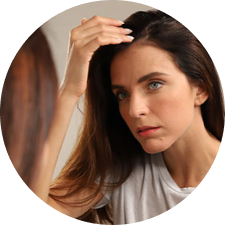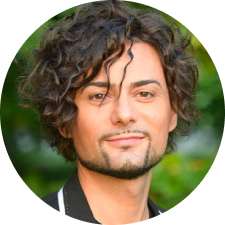- Home
- Scalp pain
scalp-problems
Scalp pain
Scientific collaboration between Professor Marco Toscani and Dr. Pasquale Fino, Chair of Plastic, Reconstructive and Aesthetic Surgery, Umberto I Health Center – “Sapienza” University of Rome.

Scalp pain and irritation (or trichodynia) are pathological conditions that affect both women (in a greater percentage) and men (in a lower percentage). The pain felt on the scalp, spontaneous or caused by treatment, and in particular around the roots of the hair, may be more or less intense, alternating at times between periods of disappearance, associated with burning, tingling or itching.
Usually, this particular scalp condition does is not located in a specific area and increases when hair is touched or brushed. Often, trichodynia is associated with hair loss. A correlation can be found between telogen effluvium and trichodynia and between seborrheic hair loss and the constant sensation of scalp pain or irritation.
Trichodynia is classified among the allodynia, conditions in which pain is felt on the skin without recognizable external causes or appears to be caused by usually innocuous stimuli. Patients suffering from this condition perceive a burning sensation and irritation on the scalp. The itchiness is so intense that thay are forced to scratch their head. The relief however is very short-lasting.
The reduction of the activation threshold of nerve endings (nociceptors), whose endings spread over the entire scalp (the pilosebaceous apparatus of each hair and the correspondent nerve endings at the level of the skin), seems to have a decisive role in triggering allodynia. The inflammation of the skin activates the nociceptors that secrete neuropeptide P, the neurotransmitter of pain. Individuals who notice this condition tend to scratch their head, pull out their hair hair to feel mild relief, but this leads to hair loss due to trichotillomania.
Although the (aforementioned) chemical process that causes skin inflammation is now known, the causes are still unclear, namely what triggers this process and how the nociceptors act. There is a strong correlation between the emotional component and trichodynia and between trichodynia and hair loss. Nervousness, stress and anxiety are associated with the appearance of scalp pain and itchiness, and with subsequent hair loss.
Another cause that triggers pain is hyperseborrhea, which leads to seborrheic dermatitis and the appearance of pain, inflammation and skin irritation. Another cause is greasy dandruff, which irritates the scalp, damaging follicular activity. Other possible causes of pain are scalp folliculitis and acne that lead to rashes, pain and itchy skin.
During the inflammatory process, the fact that the muscles of the arrector pili of the hair are forced into a strange position for long period of time may cause pain. The arrector pili muscles and the hair follicles may then become inflamed, thereby triggering the inflammatory process of the skin. Another cause of trichodynia may be neuro-muscular inflammation of skin overstressed by the tendency to grind one’s teeth, especially at night (bruxism), with the subsequent contraction of the temporomandibular joint that, with the passing of time, may involve the cranial muscles, causing headaches and trichodynia. Trichodynia should be cared for and countered with trichological treatments that aim to eliminate the underlying causes, such as hyperseborrhea and dandruff. The use of lotions and shampoos that cleanse the skin of impurities and bacteria that cause inflammation and conseuquent pain is recommended. It is also important to use remedies against hair loss.
Suitable specific and personalized therapies should be used only after a careful examination of the hair and a scrupulous skin analysis. The following treatments have proven to be useful:
1) the use of laser treatments that increase the blood capillary vasodilation necessary for providing sustenance to hair bulbs
2) treatments with high frequency rays that clean, cleanse and disinfect the scalp, improving blood supply and stimulating healthy hair growth
3) hair massages that allow follicles to expel a small amount of sebum that accumulates and facilitates the relaxation of the skin and scalp muscles.
Hair and Scalp
READ ALL ARTICLESHair Loss
READ ALL ARTICLESHair Problems
READ ALL ARTICLESScalp Problems
READ ALL ARTICLESAlopecia
READ ALL ARTICLESPreventions and Solutions
READ ALL ARTICLESHair loss solutions for you. CRLAB, specialists in the well-being of your hair and scalp.
FIND YOUR NEAREST CENTER
Let our experts find the best solution for you.
FIND YOUR NEAREST CRLAB CENTERBOOK A CONSULTATION
Book a consultation with our experts. Find out more about CRLAB solutions.
MAKE AN APPOINTMENTTrichology scalp and hair care
To put the health back into your hair, you first need to nourish your scalp. Our trichology treatments care for your scalp and hair, using cutting-edge technologies with a full range of laboratory-tested products. All made with high quality raw materials.
Find out moreHair prosthetic system
The ultimate answer to your hair loss. Rediscover yourself, with naturally thick hair. A patented solution that integrates real hair into areas where you’re experiencing thinning or hair loss. A fully customized hair enhancement that will look totally natural on you. Plus, it’s so functional, it gives you the freedom to live your life the way you want to.
Find out moreHair transplant surgery
Hair transplantation is recommended for those who wish to improve hair density and coverage. The degree of thinning may vary and must be assessed in relation to the donor area.
Find out more

 Italiano
Italiano  Português
Português  Français
Français  Español
Español 




